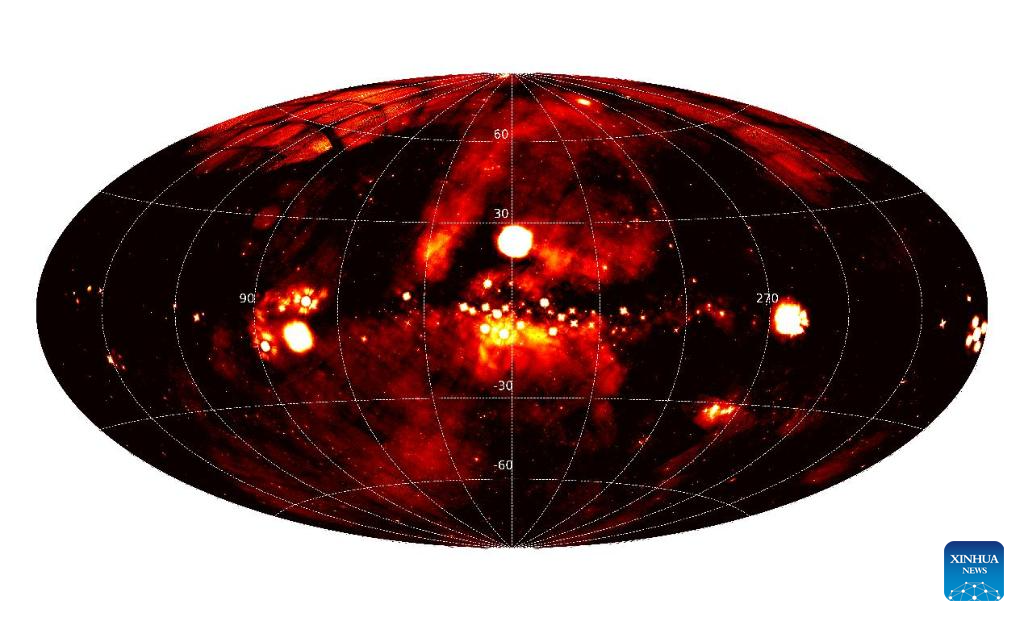2.11.2024

This image released by the Chinese Academy of Sciences (CAS) on Oct. 31, 2024 shows the first X-ray all-sky map obtained by China's Einstein Probe astronomical satellite. (Chinese Academy of Sciences/Handout via Xinhua)
China's Einstein Probe (EP) astronomical satellite, sent into space in January this year, has achieved several initial discoveries, including a mysterious uncommon transient phenomenon, assisting further understanding of the universe and extreme physical processes.
Inspired by the functions of lobster eyes, EP uses new X-ray detection technology to observe transient phenomena in the universe that flicker like fireworks, trying to reveal more about this violent and little-known side of the cosmos.
During its commissioning phase, the satellite's performance exceeded design expectations. The Chinese Academy of Sciences (CAS) announced the initial results on Thursday, including discoveries of various types of transient events.
The satellite has got another name, "Tianguan," commemorating the observation and documenting of the well-known supernova SN1054 by the ancient Chinese in 1054 A.D. This scientific feat during China's Song dynasty (960-1279) is an early example of China's contribution to human understanding of the universe. The supernova was spotted in the "Tianguan" region in the ancient Chinese constellation system, and thus named "Tianguan guest star." The ancient Chinese used the term "guest star" to refer to transient events, mostly novae and supernovae bright enough to be seen by the naked eye at that time. The supernova's debris later evolved into the famous Crab nebula.
During its commissioning and initial operation phase, EP has detected 60 confirmed transient events and many more candidates, including stars, white dwarfs, neutron stars, black holes, supernovae and gamma-ray bursts.
In the Milky Way, the satellite has discovered multiple new transient sources, one of which is a new X-ray binary system, comprising possibly a stellar-mass black hole or neutron star, designated as EP240904a.
So far, the farthest transient source detected by EP is a gamma-ray burst, coded EP240315a, some 25.6 billion light-years away. This discovery demonstrates the satellite's capacity for detecting gamma-ray bursts from the distant early universe, providing a new perspective for further understanding the physical process of stellar collapse leading to the formation of a black hole and relativistic jets, said Yuan Weimin, principal investigator of the EP mission and a researcher at the National Astronomical Observatories of CAS.
The research was led by the EP science team, in collaboration with multiple space and ground-based facilities involving a large number of international scientists from many countries and agencies.
On April 8, EP detected a transient event, coded EP240408a, and recorded a violent X-ray flare from it, which increased in brightness by 300 times and lasted for only 12 seconds. The X-ray emissions from this source disappeared approximately 10 days later.
This uncommon phenomenon, along with its other peculiar radiation properties, did not conform to the previously known types of transients, indicating that it may represent an unknown class of transient sources, Yuan said.
The discovery has been published in the latest issue of the Chinese academic journal SCIENCE CHINA: Physics, Mechanics & Astronomy.
"The most profound significance of the EP's initial results is the demonstration of EP's ability to capture and study these fleeting cosmic events. This will provide us with new insight into understanding the physical laws in extreme conditions that govern the processes in these violent cosmic events and the formation of the first stars and black holes," Yuan said.
The EP mission is one of a series of space science missions led by CAS. It is also an international collaboration mission with contributions from the European Space Agency (ESA), the Max Planck Institute for Extraterrestrial Physics (MPE) in Germany, and the French space agency CNES.
"EP has opened a new window into observing the dynamic X-ray universe," said Dr. Erik Kuulkers, EP project scientist of ESA.
EP carries two scientific instruments: a Wide-field X-ray Telescope (WXT) to monitor a panorama of the X-ray sky, and a Follow-up X-ray Telescope (FXT) to provide close-up views and pinpoint transient sources captured by the WXT.
EP has proven the importance of wide-field monitoring of the X-ray sky. The survey and follow-up capabilities have allowed for the discovery of numerous new X-ray transients and the regular monitoring of known sources. EP's discoveries show that it is already having a major effect on science, said Paul O'Brien, head of Astrophysics, School of Physics and Astronomy at the University of Leicester.
Quelle: Xinhua
